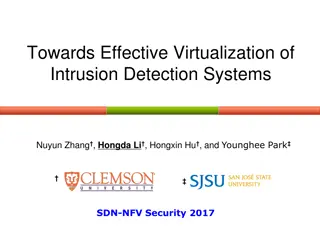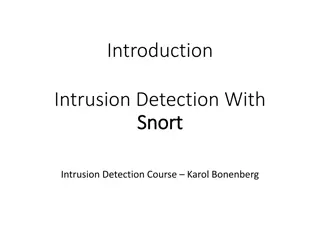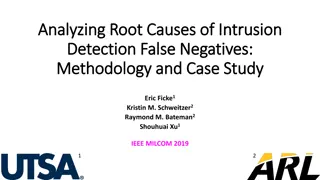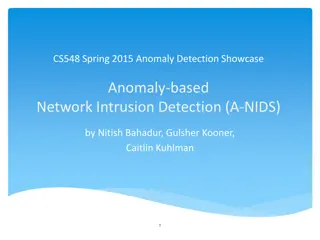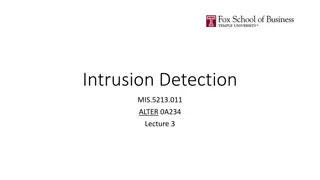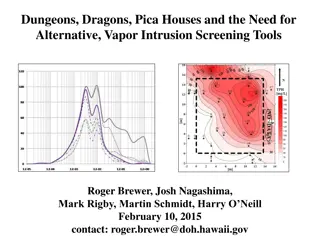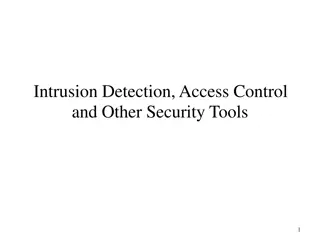Machine Learning Techniques for Intrusion Detection Systems
An Intrusion Detection System (IDS) is crucial for defending computer systems against attacks, with machine learning playing a key role in anomaly and misuse detection approaches. The 1998/1999 DARPA Intrusion Set and Anomaly Detection Systems are explored, alongside popular machine learning classifiers like K-Nearest Neighbors.
Download Presentation

Please find below an Image/Link to download the presentation.
The content on the website is provided AS IS for your information and personal use only. It may not be sold, licensed, or shared on other websites without obtaining consent from the author.If you encounter any issues during the download, it is possible that the publisher has removed the file from their server.
You are allowed to download the files provided on this website for personal or commercial use, subject to the condition that they are used lawfully. All files are the property of their respective owners.
The content on the website is provided AS IS for your information and personal use only. It may not be sold, licensed, or shared on other websites without obtaining consent from the author.
E N D
Presentation Transcript
Intrusion Detection Techniques using Machine Learning
What is an IDS? An Intrusion Detection System is a wall of defense to confront the attacks of computer systems on the internet. The main assumption of the IDS is that the behavior of intruders is different from legal users.
Types of IDS Anomaly approaches: Determine whether deviations from normal usage patterns can be flagged as intrusions Misuse or Signature detection approaches: This kind of approach uses patterns of well- known attacks to identify intrusions. Clearly Machine Learning is well suited for the first kind of approach.
The 1998/1999 DARPA Intrusion set The data set contains 24 attack types that could be classified into four main categories: Denial of Service(DOS), Remote to User (R2L), User to Root (U2R), and Probing The original data contain 744 MB data with 4,940,000 records. The data set has 41 attributes for each connection record plus one class label. Variable No Variable Name x1 duration x2 protocol_type x3 service x4 flag x5 src_bytes x6 dst_bytes x7 land x8 wrong_fragment x9 urgent x10 hot x11 num_failed_logins x12 logged_in x13 num_compromised x14 root_shell x15 su_attempted x16 num_root x17 num_file_creations x18 num_shells x19 num_access_files x20 num_outbound_cmds x21 is_host_login Variable type continuous discrete discrete discrete continuous continuous discrete continuous continuous continuous continuous discrete continuous continuous continuous continuous continuous continuous continuous continuous discrete Variable No Variable Name x22 is_guest_login x23 count x24 srv_count x25 serror_rate x26 srv_serror_rate x27 rerror_rate x28 srv_rerror_rate x29 same_srv_rate x30 diff_srv_rate x31 srv_diff_host_rate x32 dst_host_count x33 dst_host_srv_count x34 dst_host_same_srv_rate x35 dst_host_diff_srv_rate x36 dst_host_same_src_port_rate x37 dst_host_srv_diff_host_rate x38 dst_host_serror_rate x39 dst_host_srv_serror_rate x40 dst_host_rerror_rate x41 dst_host_srv_rerror_rate Variable type discrete continuous continuous continuous continuous continuous continuous continuous continuous continuous continuous continuous continuous continuous continuous continuous continuous continuous continuous continuous
Anomaly Detection Systems Three main parts in anomaly detection system are: 1. Feature selection 2. Model of normal behavior 3. Comparison
Machine Learning Techniques: 1. Single Classifiers 2. Hybrid Classifiers 3. Ensemble Classifiers
Single Classifiers K-Nearest Neighbors (k-NN) Computes the approximate distance between different points on the input vectors and assigns the unlabeled point to the class of its K-nearest neighbors. The k parameter affects performance and accuracy. k-NN is instance based learning. It contains no model training stage; only searches for examples of input vectors and classifies new distances.
Liao, Y., & Vemuri, V. R. (2002). Use of K- nearest neighbor classifier for intrusion detection. Computer and Security, 21(5), 439 448. Li, Y., & Guo, L. (2007). An active learning based TCM-KNN algorithm for supervised network intrusion detection. Computer and Security, 26, 459 467.
Single Classifiers Support Vector Machines (SVM) SVM maps the input vector into a higher dimensional feature space and obtains an optimal separating hyper-plane in the higher dimensional hyper plane. The decision boundary is determined by support vectors and extremely robust to outliers.
Chen, W.-H., Hsu, S.-H., & Shen, H.-P. (2005). Application of SVM and ANN for intrusion detection. Computer and Operations Research, 32, 2617 2634. Heller, K. A., Svore, K. M., Keromytis, A. D., & Stolfo, S. J. (2003). One class support vector machines for detecting anomalous window registry accesses. In Paper presented at the 3rd IEEE conference data mining workshop on data mining for computer security. Florida. Khan, L., Awad, M., & Thuraisingham, B. (2007). A new intrusion detection system using support vector machines and hierarchical clustering. The VLDB Journal, 16, 507 521. Tian, M., Chen, S. -C., Zhuang, Y., & Liu, J. (2004). Using statistical analysis and support vector machine classification to detect complicated attacks. In Paper presented at the proceedings of the third international conference on machine learning and cybernetics. Shanghai.
Single Classifiers Artificial Neural Networks Information is processed in units that mimic neurons. Multi-Layer Perceptron: Consists of an input layer including a set of sensory nodes as input nodes, one or more hidden layers of computation nodes and an output layer. Each interconnection has a scalar weight associated with it that is calculated during the training phase.
Artificial Neural Networks Chen, Y., Abraham, A., & Yang, B. (2007). Hybrid flexible neural-tree-based intrusion detection systems.International Journal of Intelligent Systems, 22, 337 352.
Chen, Y., Abraham, A., & Yang, B. (2007). Hybrid flexible neural-tree-based intrusion detection systems. International Journal of Intelligent Systems, 22, 337 352. Joo, D., Hong, T., & Han, I. (2003). The neural network models for IDS based on the asymmetric costs of false negative errors and false positive errors. Expert System with Applications, 25, 69 75. Liu, G., Yi, Z., & Yang, S. (2007). A hierarchical intrusion detection model based on the PCA neural networks. Neurocomputing, 70, 1561 1568. Moradi, M., & Zulkernine, M. (2004). A neural network based system for intrusion detection and classification of attacks. In Paper presented at the proceeding of the 2004 IEEE international conference on advances in intelligent systems Theory and applications. Luxembourg. Zhang, C., Jiang, J., & Kamel, M. (2005). Intrusion detection using hierarchical neural network. Pattern Recognition Letters, 26, 779 791.
Single Classifiers Self-Organizing Maps (SOM) Used to reduce the dimension of data for visualization. SOM projects and clusters high dimensional input vectors into a low dimensional (usually 2) visualization map. Consists of an Input layer and a Kohonen layer. The Kohonen layer is a two dimensional arrangement of neurons that maps the n-dimensional input to two dimensions. SOM maps similar input vectors onto the same or similar output units on the two dimensional map. Outputs self-organize to an ordered map and output units with similar weights are placed nearby after training.
Hierarchical SOM architecture (a) Architecture (b) Data partitioning Kayacik, H. G., Nur, Z.-H., & Heywood, M. I. (2007). A hierarchical SOM-based intrusion detection system. Engineering Applications of Artificial Intelligence, 20, 439 451.
Single Classifiers Decision Trees A sample is classified through a sequence of decisions, in which the current decision helps to make the subsequent decision. Tree structure where each node is a decision and each leaf a classification category.
Final Decision Tree Classifier Randomly Generated Population Decision Tree Constructor Decision Tree Evaluator Feature Selection Fitness Computation Training Data Validation Data Testing Data Generate Next Generation GA/Decision Tree Hybrid Stein, G., Chen, B., Wu, A. S., & Hua, K. A. (2005). Decision tree classifier for network intrusion detection with GA-based feature selection. In Paper presented at the proceedings of the 43rd annual Southeast regional conference. Kennesaw, Georgia.
Single Classifiers Na ve Bayes Networks (NBN) Provides an answer to questions like What is the probability that it is a certain type of attack, given some observed system events , by using a conditional probability formula. Usually represented by a directed acyclic graph (DAG), where each node represents one of the system variables and each link encodes the influence of one node upon another. Scott, S. L. (2004). A Bayesian paradigm for designing intrusion detection systems. Computational Statistics and Data Analysis, 45, 69 83.
Single Classifiers Genetic Algorithms (GA) Uses the computer to implement the natural selection and evolution. GA usually starts by randomly generating a large population of candidate programs. Some type of fitness measure is used to evaluate the performance of each individual in a population. A large number of iterations is then performed where low performing programs are replaced by genetic recombinations of high-performing programs. Abadeh, M. S., Habibi, J., Barzegar, Z., & Sergi, M. (2007). A parallel genetic local search algorithm for intrusion detection in computer networks. Engineering Applications of Artificial Intelligence, 20, 1058 1069. Liu, Y., Chen, K., Liao, X., & Zhang, W. (2004). A genetic clustering method for intrusion detection. Pattern Recognition, 37, 927 942.
Single Classifiers Fuzzy Logic Fuzzy set theory the degree of truth of a statement is not 0 or 1 but it can range between the two truth values (true/false). Chavan, S., Shah, K. D. N., & Mukherjee, S. (2004). Adaptive neuro-fuzzy intrusion detection systems. In Paper presented at the in proceedings of the international conference on information technology: Coding and computing (ITCC 04). Florez, G., Bridges, S. M., & Vaughn, R. B. (2002). An improved algorithm for fuzzy data mining for intrusion detection. In Paper presented at the proceedings of the North American fuzzy information processing society conference (NAFIPS 2002). New Orleans, LA.
Incorrect (Training Needed) Correct (No Training) Teacher Winner (Decision) Y(1) Y(2) Y(3) Y(n) 1 2 3 n w1 w2 w3 wn X(1) X(2) X(3) X(4) Chavan, Sampada, et al. "Adaptive neuro-fuzzy intrusion detection systems. "Information Technology: Coding and Computing, 2004. Proceedings. ITCC 2004. International Conference on. Vol. 1. IEEE, 2004.
Hybrid Classifiers Typically consists of two functional components. The first one takes raw data a input and generates intermediate results. The second one takes the intermediate result as an input and produces the final result.
Examples of Hybrid Classifiers a. Cascading classifiers: For example neuro- fuzzy techniques b. Clustering based approach to process the input and eliminate outliers, then results are used as training examples for a classifier. c. Integrating techniques where the first aims to optimize the learning performance (parameter tuning) of the second model for prediction
Peddabachigari, S., Abraham, A., Grosan, C., & Thomas, J. (2007). Modeling intrusion detection system using hybrid intelligent systems. Journal of Network and Computer Applications, 30, 114 132. Shon, T., & Moon, J. (2007). A hybrid machine learning approach to network anomaly detection. Information Sciences, 177, 3799 3821.
Hybrid Decision Tree SVM Approach Support Vector Machine Intrusion Detection Data Decision Trees Peddabachigari, Sandhya, et al. "Modeling intrusion detection system using hybrid intelligent systems." Journal of network and computer applications 30.1 (2007): 114-132.
Shon, T., & Moon, J. (2007). A hybrid machine learning approach to network anomaly detection. Information Sciences, 177, 3799 3821.
Ensemble Classifiers Combination of multiple weak learners. The learners are trained on different samples to improve the overall performance. To combine the outputs of the weak learners the most common techniques are: a. Majority Rule b. Boosting c. Bagging
Intrusion Detection as a Pattern Recognition Problem Multiple Classifier System for Intrusion Detection Giacinto, Giorgio, Fabio Roli, and Luca Didaci. "Fusion of multiple classifiers for intrusion detection in computer networks." Pattern recognition letters 24.12 (2003): 1795-1803.
Neural Networks (Backpropagation) Neural Networks (Scale Conjugate Gradient) Data Neural Network (One Step Secant) Ensemble preprocessor Support Vector Machine Multivariate Regression Splines Mukkamala, Srinivas, Andrew H. Sung, and Ajith Abraham. "Intrusion detection using an ensemble of intelligent paradigms." Journal of network and computer applications 28.2 (2005): 167-182.
Classification Problems Inputs are divided into two or more classes, and the learner must produce a model that assigns unseen inputs to one or more of these classes. This is typically tackled in a supervised way. Anomaly detection can be described as a classification problem: Activities are divided into normal and not normal .
Outlier detection: Closed world assumption The idea that specifying only positive examples and adopting the standing assumption that the rest are negative is not of much practical use in real-life problems because they rarely involve closed worlds in which you can be certain that all cases have been covered.
High cost of errors A very small rate of false positives can render a NIDS unusable: operators wasting too much time looking at incident reports of benign activity. Even one false negative might compromise the entire IT infrastructure.
Diversity of network traffic Network characteristics Bandwidth Duration of connections Application mix Can vary a lot, rendering them unpredictable over short intervals of time
Semantic gap It is very challenging to translate the results from a classifier into a report that can be read by a human. Systems are not designed to identify malicious behavior, but rather, behavior that has not been seen before.
Only two publicly available datasets: DARPA Network traces dataset KDD Cup dataset. Best way to train is real network data, but it is difficult to anonymize. KDD Lack of training Data
Recommendations for using machine learning Understand what the system is doing Understand the Threat Model Target environment Attack cost Who are the attackers Robustness requirements Keep the scope narrow Reduce the costs












